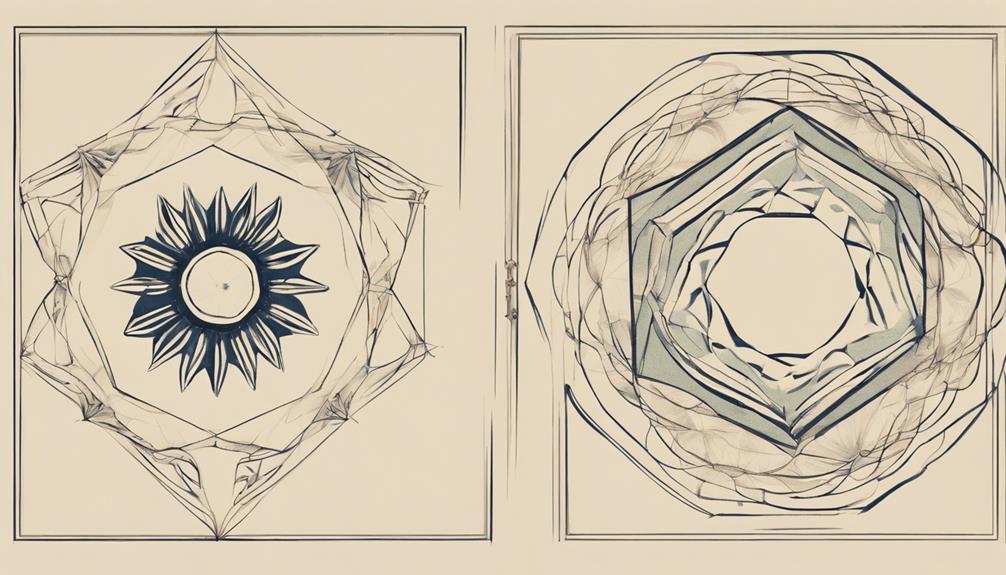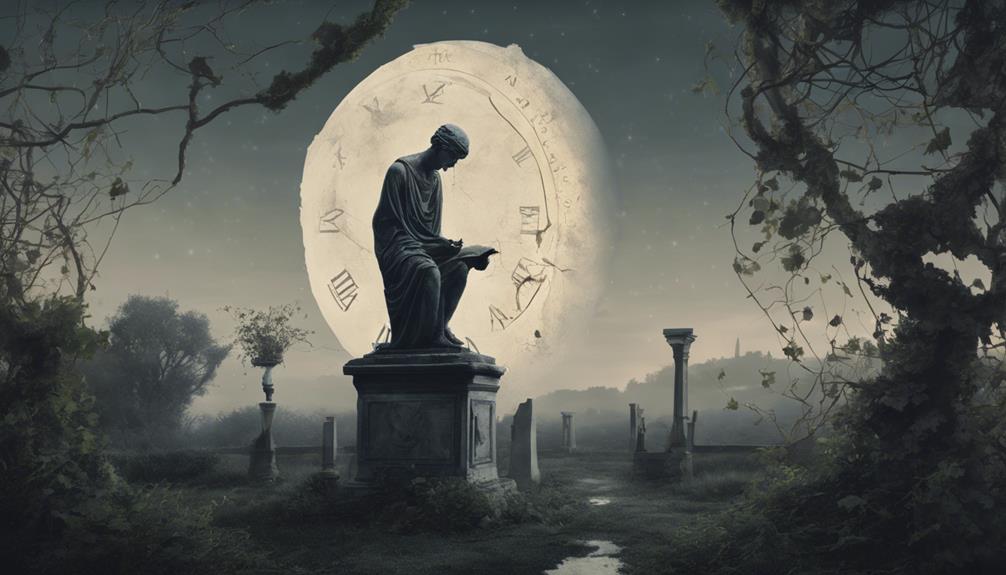As you venture into the world of sonnet mastery, you'll discover the intricate structures and themes of Shakespearean and Petrarchan sonnets. The Shakespearean sonnet, with its 14 lines and four quatrains, enables the exploration of complex ideas and emotions. The Petrarchan sonnet, characterized by an octave and a sestet, facilitates nuanced exploration of emotions and ideas. Themes of love and beauty, mortality and the passage of time, are woven throughout these poetic forms. As you navigate the conventions and variations of these sonnets, you'll uncover the intricate exploration of form and content, and perhaps, stumble upon a deeper understanding of the sonnet's enduring allure.
Understanding Shakespearean Sonnet Structure

When exploring the domain of Shakespearean sonnets, it's essential to comprehend the underlying structure, which typically consists of 14 lines, divided into four quatrains and a final couplet, a deliberate design that enables the poet to explore complex ideas and emotions with remarkable depth and nuance. This structure allows you to skillfully weave together rhetorical devices, such as metaphor, personification, and allusion, to convey rich and layered meanings. As you navigate the sonnet's evolution, you'll notice how Shakespearean sonnets often diverge from the traditional Italian sonnet, embracing a more flexible and expressive form. This freedom enables poets to experiment with language, tone, and theme, resulting in a diverse range of sonnets that continue to captivate readers. By grasping the intricacies of Shakespearean sonnet structure, you'll gain a deeper understanding of the poet's craft, and the ways in which they skillfully employ rhetorical devices to convey the human experience.
Petrarchan Sonnet: Octave and Sestet

As you explore the world of Petrarchan sonnets, you'll discover that the traditional Italian form is characterized by an octave, comprising eight lines, and a sestet, consisting of six lines, which together facilitate a nuanced exploration of emotions and ideas. This structural dichotomy allows poets to present a problem or question in the octave, followed by a resolution or answer in the sestet. This division enables a more profound examination of themes, as the octave often presents a dilemma or emotional turmoil, while the sestet provides a moment of insight or catharsis. The Petrarchan legacy has greatly influenced the sonnet evolution, with its unique structure allowing poets to craft complex, multi-layered explorations of the human experience. As you immerse yourself further into the world of Petrarchan sonnets, you'll uncover the richness and complexity of this traditional form, which continues to inspire poets and readers alike.
Themes of Love and Beauty

In Petrarchan sonnets, the themes of love and beauty often serve as a catalyst for poetic exploration, allowing you to investigate the complexities of the human experience. As you explore these sonnets, you'll discover that love and beauty are often intertwined, with beauty serving as a trigger for romantic emotions. This fusion of themes enables poets to examine the sensual intimacy that arises from romantic connections, as well as the emotional turmoil that often accompanies it.
Through the Petrarchan sonnet's carefully crafted structure, poets can convey the intense emotions and desires that accompany romantic love. The octave typically sets the tone for the poem, introducing the themes of love and beauty, while the sestet provides a space for poetic reflection and introspection. As you analyze these sonnets, you'll find that poets often use imagery and metaphor to convey the intense emotions that accompany romantic love, creating a sense of urgency and passion that draws the reader in.
Mortality and the Passage of Time

Delving into the domain of mortality and the passage of time, you'll discover that Petrarchan sonnets often lament the transience of human existence, with poets grappling with the fleeting nature of beauty and the inevitability of decay. These sonnets poignantly capture the ephemeral moments that comprise our lives, revealing the tension between the brevity of human experience and the desire for a lasting, temporal legacy.
As you immerse yourself in these sonnets, you'll find that poets frequently employ metaphors of seasonal change, emphasizing the cyclical nature of life and death. This poetic device serves to underscore the impermanence of human achievement, highlighting the futility of attempting to defy mortality. Through their masterful use of language, Petrarchan sonnets convey the bittersweet essence of human existence, where the pursuit of eternal legacy is constantly threatened by the inexorable passage of time.
Exploring Sonnet Conventions and Variations

Through a nuanced understanding of sonnet conventions, you'll uncover the intricate exploration of form and content, where poets deftly navigate the tension between adherence to traditional structures and innovative deviations that redefine the genre. As you investigate further, you'll find that sonnet evolution is closely tied to cultural influences, with each era and region leaving its unique mark on the form. The sonnet's adaptability has allowed it to thrive across centuries, from the Italian Renaissance to the English Romantic era. By examining the variations in sonnet structures, themes, and styles, you'll gain insight into the cultural and historical contexts that shaped the genre. From the strict rhyme schemes of the Petrarchan sonnet to the more flexible structures of the Shakespearean sonnet, each variation reflects the aesthetic and philosophical values of its time. As you explore the sonnet's rich cultural heritage, you'll develop a deeper appreciation for the intricate interplay between form and content that defines this timeless poetic form.
Mastering the Art of Sonnet Writing

As you begin the challenging yet rewarding journey of mastering the art of sonnet writing, you'll need to carefully balance creativity with adherence to traditional forms, all while cultivating a deep understanding of the nuances that distinguish a truly exceptional sonnet. This delicate balance allows you to harness the creative freedom that sonnet evolution has afforded, while still honoring the time-honored conventions that have come to define the form.
As you navigate the complex landscape of sonnet writing, you'll find that the most effective sonnets are those that strike a balance between innovation and tradition. By understanding the historical context and evolution of the sonnet, you'll be better equipped to push the boundaries of the form while still paying homage to its rich heritage.
Ultimately, mastering the art of sonnet writing requires a deep understanding of the intricate interplay between creative freedom and traditional form. By embracing this tension, you'll be able to craft sonnets that are both innovative and timeless, contributing to the ongoing evolution of this timeless poetic form.
Famous Examples and Their Significance
In exploring the rich tapestry of sonnets, you'll encounter a plethora of renowned examples that have not only shaped the form but also continue to inspire poets and scholars alike. From Shakespeare's Sonnet 18, 'Shall I Compare Thee to a Summer's Day?', to Petrarch's Sonnet 134, 'If I Could Only Hear Your Voice', these iconic poems have left an indelible mark on the literary canon.
These famous sonnets possess historical significance, as they reflect the cultural and social nuances of their time. Shakespeare's sonnets, for instance, offer a window into the Elizabethan era's fascination with love, beauty, and mortality. Meanwhile, Petrarch's sonnets exemplify the Renaissance humanist ideals of intellectual curiosity and emotional depth.
Their cultural relevance extends far beyond their historical context, however. These sonnets continue to influence contemporary poetry, with their exploration of universal themes such as love, identity, and the human condition. As you investigate these masterpieces, you'll discover how they have shaped the sonnet form and continue to inspire new generations of poets and readers alike.
Frequently Asked Questions
Can Anyone Write a Sonnet, or Is It Only for Experts?
You ponder whether anyone can write a sonnet, or if it's reserved for experts. The truth is, creative freedom is essential to crafting a sonnet, regardless of expertise. While literary merit often stems from mastery of form and technique, a novice can still produce a compelling sonnet by embracing the structure and themes that define the genre. Your unique voice and perspective can shine through, even if your skills are still developing.
How Do I Choose the Right Rhyme Scheme for My Sonnet?
When choosing a rhyme scheme for your sonnet, you'll want to engage in rhyme scheme analysis, considering the poem's tone, theme, and intended audience. Don't be afraid to take poetic license, exploring unconventional schemes to convey your unique voice. Weigh the constraints of traditional forms against the freedom of innovation, striking a balance that elevates your message.
Can I Write a Sonnet About Any Topic I Want?
You're free to explore any topic that resonates with you, exercising personal freedom in your sonnet's subject matter. You can tackle contemporary themes, allowing your voice to resonate with modern audiences. The sonnet form, with its rich history, can now be harnessed to address issues that matter most to you, from social justice to personal struggles, giving your work a sense of urgency and relevance.
Are There Any Modern Sonnet Forms or Variations?
You're likely familiar with Marilyn Nelson's "A Wreath for Emmett Till," a contemporary sonnet sequence that challenges traditional forms. This example illustrates that, yes, modern sonnet forms do exist. In fact, contemporary sonnets often experiment with non-traditional structures and themes, giving rise to experimental forms that push the boundaries of the classical sonnet. These innovative approaches have expanded the sonnet's possibilities, allowing poets to explore new modes of expression.
Can Sonnets Be Written in Languages Other Than English?
You might assume sonnets are inherently tied to the English language, but that's not the case. Sonnet traditions have been adapted and translated across languages, celebrating linguistic diversity. From French to Italian, Spanish to Portuguese, sonnets have been written in numerous languages, often blending cultural influences. You'll find that sonnets have been penned in languages as diverse as Arabic, Chinese, and even Hindi, showcasing the versatility of this poetic form.


